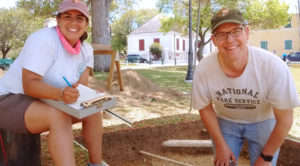Just outside the door of the National Park Service lecture room in the Danish Company Warehouse on Company Street, Christiansted, is the place where thousands of Africans were auctioned off as slaves. Thursday night the lecture room was filled with about 100 people who learned about where many of those slaves may have begun their journey.

Archeologists from Mozambique and Senegal presented the research results they have gleamed from working the Slave Wrecks Project.
“A healthy society cannot remain oblivious to its past,” said Ibrahima Thiaw, an archaeologist from the University of Dakar, Senegal, who documented some of the changes the slave trade forced on communities in Senegal.
He said the slave trade fragmented African communities, and colonizers challenged local beliefs. He said the slave trade might have also been the reason for so many hilltop villages in Senegal. Hilltop villages would be easier to defend from would-be slavers, but such villages made obtaining water difficult.
“Unpacking the legacies of slavery will help tackle problems of citizenry, nationality and social justice,” he said.
Celso Simpine, from Mozambique, told about a search going on near Mozambique Island for slave ship wrecks. One wreck he showed special interest in was that of the L’Aurore, which sank with 600 slaves aboard. (The largest slave ships held up to 700 slaves). Slaves rose in revolt on L’Aurore two days before its departure but the revolt was put down. On the day of departure a storm came ashore and the ship began to drift toward a reef. An anchor was dropped, it broke; a second anchor was dropped, it broke too. The ship crashed upon the reef. Although, the sinking of the ship was well documented, little so far has been recovered of the wreck.
Since 2010, the Slave Wrecks Project has used maritime archeology to examine enslavement and its global impacts. The archeological investigation of slaver shipwrecks also includes a component of related terrestrial sites, such as markets in which the enslaved were sold, maroon sites and encampments, and free black communities, according to the speakers.
In 2015, the NPS launched the Slave Wreck Project research at Buck Island National Monument and Christiansted National Historic Site on St. Croix.
At Thursday’s presentation, members of the NPS project team were asked by an audience member where the wreck sites were and if they were open to the public, which might want to dive them. She was told that one wreck was off Buck Island and one was off Salt River. NPS Superintendent Joel Tutein said the sites were not open to the public. He added that the sites did not look like “sunken wrecks in a Disney movie,” that the years had taken a toll on the wrecks.
The African archaeologists were in the Virgin Islands for an 11-day program on protecting and preserving cultural heritage sites on land and beneath the ocean. As part of their studies, participants work to understand what makes heritage sites like those in Christiansted important to the communities nearby. This training is coordinated by the NPS and the U.S. Department of State’s Bureau of Educational and Cultural Affairs.
A representative from the Smithsonian Institution’s National Museum of African American History and Culture which is collaborating on the Slave Ship Project also attended the lectures. She mentioned that there would be ongoing projects this summer on St. Croix which she called a “significant” historic site.
A member of the NPS team told the audience, “It is important to bring back into memory a very difficult part of our heritage.”
The Friends of the St. Croix USVI National Parks sponsored the lecture.





